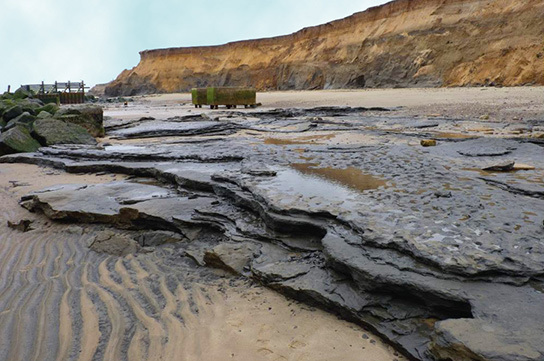Archaeologists Discover Ancient Hominin Footprints In The UK
This article is more than 2 years old
 Happisburgh, on the eastern coast of England, is a little-known goldmine of information and relics from the Stone Age. A few years ago, archaeologists discovered remains in Happisburgh that they believe are roughly 800,000 years old — the oldest site of human civilization ever found in that region of the world. Now, Happisburgh has delivered more ancient evidence, the oldest footprints ever discovered outside of Africa.
Happisburgh, on the eastern coast of England, is a little-known goldmine of information and relics from the Stone Age. A few years ago, archaeologists discovered remains in Happisburgh that they believe are roughly 800,000 years old — the oldest site of human civilization ever found in that region of the world. Now, Happisburgh has delivered more ancient evidence, the oldest footprints ever discovered outside of Africa.
In their paper recently published in PLOS One, archaeologists date these footprints somewhere between 780,000-1,000,000 million years ago, with estimates settling in around 900,000 years ago. Last year, archaeologists were surveying the Norfolk coastline, which is eroding at a rapid pace and revealing sediment and other ancient formations. The window of opportunity is short, though — the rate of erosion is fast enough that even when some ancient goodies are exposed, they’re quickly washed away.
The archaeologists call it chance that when they visited the area, the sand had been washed away, leaving some very old mud behind. But this mud had some unusual characteristics — hollows and indentations that were unexpected and hard to explain — that is, until one of the archaeologists suggested that they might be footprints. At first they were skeptical, given that the sediments there are over 800,000 years old, but as they ruled out other possibilities and examined the hollows more, they became increasingly confident that they were looking at prints.

They photographed the prints using a technique called photogrammetry, which processes and analyzes multiple images to obtain information about where they came from, and when, and provides a 3-D rendering of the image. The results from that analysis sealed the deal — scientists could discern toes, heels, and arches from the prints and estimate that they were made by approximately five people, a combination of adults and children. They don’t know exactly who these people were, but the dates suggested they were hominins rather than hominids, the difference being that the former consists of the immediate ancestors of Homo sapiens, while the latter consists of modern and extinct Great Apes, perhaps even the “Pioneer Man,” a bi-pedal Homo antecessor with smaller brains than Homo sapiens.
The evidence from Happisburgh also suggests that these ancient ancestors were able to weather worse winters than we’re experiencing here and now (are they taking the polar vortex into account?) That raises questions of how they survived. What did they wear? What kind of shelters did they make? Did they use fire way back then? Clearly, they had some methods of adapting to the weather that scientists hadn’t previously attributed to people living in the area at that time. Scientists believe that they foraged for food and other resources along the coast, and that they were one phase of the sporadic and episodic inhabitance of ancient Britain. In fact, scientists think that roughly 10 waves of inhabitants have roamed Britain over the years, perhaps comprised of four different species. That makes me wonder what the 11th phase will look like…












